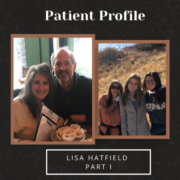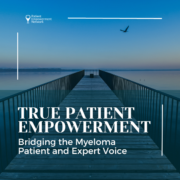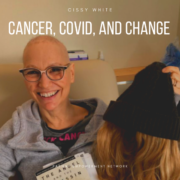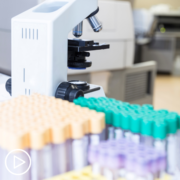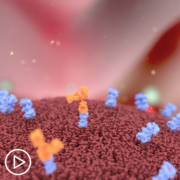Patient Profile: Lisa Hatfield Part I
This begins a five-part series from empowered multiple myeloma patient Lisa Hatfield. In Lisa’s candid and compelling telling of her cancer journey, she shares her story from diagnosis in 2018 to how she lives well with cancer in 2021. Lisa provides thoughtful feedback about becoming an empowered patient and the value of Patient Empowerment Network (PEN) as a resource, and she offers her advice to anyone newly diagnosed with cancer: Learn, Breathe, Feel, Share, Live, Connect, and Hope. In Part One Lisa tells her story.
April 30, 2018
Two hours after the MRI, my doctor, having received a call from the radiologist: “Lisa, it’s Mike. I just received the results from your MRI.” This didn’t sound good. “You have a tumor on your spine. These types of tumors are almost always malignant,” he said. “In fact, I’m just going to say, it’s a malignancy. Can you and Lance come and see me first thing in the morning?” My world stopped.
Backing up a couple of years, I’d been battling a variety of aches and pains. Usually brushing them off and attributing them to aging, improper body mechanics, being out of shape, and garden-variety stress from the busy-ness of life, I got along okay. Until I couldn’t. The year prior to diagnosis, I had suffered from a frozen shoulder on my left side, then right. I maxed out my physical therapy sessions in an attempt to alleviate a weird hip pain that occasionally felt better after PT, but progressively worsened over time. Walking and attempting daily tasks (like crawling into bed) resulted in significant pain. I was not thriving.
Back to d(iagnosis)-day, 2018, we met with Dr. Mike and continued the week with a dizzying schedule of appointments, phone consults, procedures, tests, and communications with various other medical personnel.
I had a plasmacytoma (tumor) that had “eaten away” at my spine at the T-12 level. My diagnosis: multiple myeloma. Multiple myeloma, myeloma for short, is a blood cancer, originating in the bone marrow. The first radiation oncologist we saw described myeloma as a “liquid” cancer. I thought it was an odd explanation. I later learned that “liquid” is in contrast to a “solid” cancer, such as breast cancer or colon cancer, which typically involve masses or tumors. This didn’t matter much, other than the notion that I had both a liquid and solid aspect of myeloma. My treatment required managing the plasmacytoma (solid) and the actual cancer in the bone marrow (liquid). Myeloma develops in the plasma cells of the bone marrow, the soft, spongy center of the bone. Plasma cells are a type of white blood cell and are important for producing antibodies to maintain the immune system. In myeloma, for reasons yet determined, the healthy plasma cells turn into malignant cells (myeloma cells). These myeloma cells replicate and “crowd out” the good cells. This transformation results in fewer “good” antibodies, which is why many myeloma patients complain of frequent infections prior to their myeloma diagnosis.
Myeloma is incurable.
I live in Boise, Idaho. A nice, small city with good, reliable health care but no myeloma specialists. The best decision we made regarding my diagnosis was to seek a second, expert opinion. Two weeks after that dreadful call, we were at MD Anderson Cancer Center in Houston.
My myeloma diagnosis was confirmed with a bone marrow biopsy. For anyone with myeloma, you might be curious to know that I was diagnosed with monosomy 13 and translocation (11;14). These are genetic mutations found on the myeloma cells. I have Kappa Lightchain Myeloma.
The most pressing issue was the plasmacytoma, as the location and growth had compromised my spine. My doctors indicated the cancer was secondary to the spinal cord compression. It didn’t feel secondary to me, as they described “scattered lesions”, or holes, throughout my skeleton, including my skull. I wanted to know about the cancer more than the spine damage. The team at MD Anderson worked closely, one specialist often conferring with another, as I sat in the room listening to their conversations. It was quickly decided that I would begin radiation immediately. Radiation served to shrink the tumor and destroy malignant cells. Radiation was a bit difficult, as the tumor and surrounding area became inflamed and swelled, creating significant pain, but that was short-lived, lasting eight days. On the last day of radiation, I was wheeled into surgery for spine stabilization. The partial vertebra was not removed, as this was deemed too risky. The procedure did stabilize my spine and prevented further collapse and spinal cord injury. After five days in the hospital and a couple nights at a nearby hotel, we flew home.
My medical oncologist in Houston devised a “chemo cocktail,” which included a drug only accessible to specialists. For six months, I went to our local hospital every Wednesday and Thursday to have this cocktail administered intravenously. I have great memories of those six months. Truthfully. Meeting people each day, seeing the weekly “regulars,” and spending several hours with my girlfriends is one of the most memorable periods of my life. Funny how the mind works. Those moments are deeply embedded and overpower memories of the lousy side effects.
Standard of care for myeloma patients is chemo, followed by an autologous stem cell transplant (ASCT). Transplant is not a cure for myeloma, but research has shown that it can lead to a longer remission if it “takes.” Due to multiple factors, I chose to have my stem cells harvested and stored, rather than harvested and transplanted. Once the six months of chemo was complete, we traveled to Seattle for three weeks for re-staging and stem cell harvest. My stem cells are securely frozen and ready for future use.
Bilateral bone marrow biopsies (one in each hip bone) confirmed that I had an excellent response to chemo, and I’ve graduated to maintenance chemo. Thankfully, my current cancer drugs are oral, so I only report to the cancer center once a month for labs and an oncologist visit. Because there is no cure for myeloma, I’ll be on these drugs forever. They’re not fun, but they’re tolerable. They keep my myeloma numbers down so my body doesn’t have to fight so hard. My spine is healing and there is a possibility that some of the bone could grow back. My neurosurgeon recommended limiting activities to walking and swimming forever, but I’ve snuck in a few easy hikes with my family.
I’m hoping for a cure, but in the meantime, I’m enjoying life as it is. It’s really good.
Present Day
Until there is a cure, I’ll always have cancer. It’s a part of me and a part of my story. My biggest takeaway is that it’s a new life. It’s not a new normal. With daily reminders, such as pill-taking, side effects, and scars, nothing feels “normal.” It’s a new life. In addition to the daily reminders, I have deeper friendships and connections, I understand the importance of slowing down and not letting the “white noise” of life overwhelm me, and I feel so grateful for each new day. The greatest takeaway is that over time, the triumphs grow bigger than the scars; and this new life, though not without stress and suffering, would not be possible without cancer. It’s the best life I’ve ever had.
Read part II of Lisa’s story here.
Jennifer Lessinger is a professional writer and editor who learned the value of patient empowerment during her struggle with a hard-to-diagnose and complex endocrine disorder.

